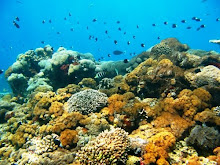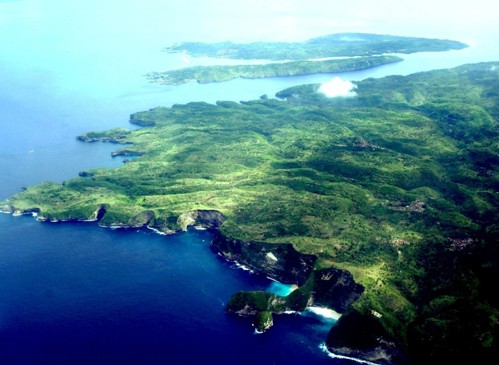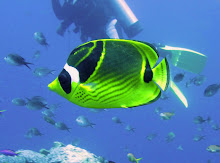JAKARTA – Pada akhir Maret 2009 lalu, beberapa penyelam di Pulau Air di Kepulauan Seribu, dikagetkan dengan kehadiran seekor ikan mola-mola kecil. Kaget, karena tak pernah ikan mola-mola ditemukan di wilayah itu. Lebih terkejut lagi ketika si kecil Mola kemudian mati, beberapa saat setelah ditemukan para penyelam tersebut.
Apen Sukmawijaya, salah seorang staf di Taman Nasional Laut Kepulauan Seribu (TNKS) menceritakan kejadian tersebut, baru-baru ini. “Ikan itu tiba-tiba saja muncul,” katanya. Ukurannya yang masih kecil, menunjukkan bahwa ikan ini masih bayi, bila dibandingkan dengan induknya yang bisa bertubuh tiga kali lebih besar daripada manusia dewasa. Sayangnya, beberapa saat kemudian ikan tersebut mati.
Dari beberapa penelitian, mola-mola pernah ditemukan di beberapa tempat di Indonesia. Di Nusa Penida Bali, kehadirannya kerap dijadikan promosi wisata. Selain itu, di Taman Nasional Komodo di Nusa Tenggara Timur (NTT), Taman Nasional Wakatobi di Sulawesi Tenggara (Sultra), dan Kepulauan Raja Ampat di Papua Barat, kadang ditemukan spesies mola-mola.
Sepanjang tahun 2008, kehadiran ikan mola-mola teridentifikasi di Molas dan Talise di Sulawesi Utara. Di Molas ditemukan karena terkena jaring nelayan, kemudian mati dan dipotong-potong warga. Sementara yang ditemukan di Talise, sempat diberi perlakuan khusus agar tetap hidup, tapi sayangnya tetap menemui ajal juga. Sementara kehadiran ikan mola-mola di Kepulauan Seribu baru pertama kali ini terjadi. Kemunculan mola-mola itu tak bisa dianggap biasa.
“Ikan mola-mola adalah ikan laut dalam (ditemukan hingga kedalaman 600 meter, rata-rata 200 meter), maka ada kemungkinan yang di Nusa Penida berasal dari Samudra Hindia. Mereka “mampir” ke perairan Nusa Penida untuk membersihkan parasit di tubuhnya dengan bantuan ikan karang dan “berjemur” untuk mendapatkan sinar matahari,” urai Marthen Welly, Pimpinan Proyek The Nature Conservancy (TNC) untuk Nusa Penida, melalui surat elektronik, awal bulan ini.
Pada waktu-waktu tertentu, ikan mola-mola naik ke permukaan, sebagai penyesuaian suhu tubuhnya akibat terlalu lama berada di laut dalam, yang memiliki suhu rendah. Itu sebabnya ikan ini kadang disebut sebagai oceanic sunfish, karena kerap dijumpai sedang “berjemur” di perairan dangkal sekitar samudra. Selain berjemur ikan yang bisa memiliki tubuh hingga 3,2 meter ini suka berada di daerah terumbu karang. Lantaran dengan bantuan ikan karang seperti ikan bidadari (angle fish) dan ikan bendera (banner fish), ikan mola-mola bisa membersihkan dirinya.
Dari perilaku itu, maka wajar bila mola-mola juga terlihat di daerah Manado yang merupakan salah satu daerah dengan terumbu karang terbaik di Indonesia. Ditemukannya mola-mola di Taman Nasional Komodo, Wakatobi dan Kepulauan Raja Ampat juga masuk akal. Namun akan menjadi pertanyaan besar, ketika ikan itu juga terlihat di Kepulauan Seribu.
Tak Wajar
Augy Syahilatua dari Pusat Penelitian Oseanografi-Lembaga Ilmu Pengetahuan Indonesia (P2O-LIPI), memperkirakan kematian mola-mola tak wajar. Mengingat biasanya ikan ini hidup pada kedalaman 30-480 meter, menurut teori Fishbase, tahun 2009. Marthen Welly mengemukakan asumsi serupa. Menurutnya, perairan TN Kepulauan Seribu kerap tercemar oleh tumpahan minyak.
Terlepas dari berbagai teori kematian itu, kerusakan lingkungan hidup juga dapat menjadi penyebabnya. Seperti berkurangnya sumber makanan mola-mola seperti ubur-ubur, udang, zooplankton, cumi dan ikan-ikan kecil. “Bahkan ikan mola-mola kerap dijumpai mati akibat memakan sampah plastik di laut yang mereka kira ubur-ubur,” lanjut.
Sementara penyebab ikan tersebut ada di Kepulauan Seribu, dianalisis karena semakin berbedanya kondisi suhu lautan akibat pemanasan global. Seperti di Nusa Penida, beberapa penyelam pernah menjumpai mola-mola pada Desember-Januari, padahal biasanya antara Juli–September. Diperkirakan perubahan iklim akibat kerusakan lingkungan turut memengaruhi perilaku mola-mola, karena suhu air laut juga berubah. Ketersediaan makanan yang semakin berkurang dan semakin sedikitnya ikan bidadari dan ikan bendera akibat kerusakan terumbu karang juga kian memperlihatkan perilaku mola-mola yang menyimpang.
Kematian mola-mola kecil di Kepulauan Seribu, bisa jadi lantaran terpisah dari kelompok besar atau induknya, sementara panas laut kemudian mengantarnya ke perairan utara Jakarta yang hangat. Namun karena kondisi lingkungan yang buruk di sana serta buruknya kualitas makanan, ikan tersebut akhirnya menemui ajal. Sayangnya, belum ada studi yang mendalam tentang hal ini. Seperti jalur ruaya (imigrasi) ikan mola-mola dan beberapa perilaku yang belum diketahui.
Kini ikan mola-mola yang ditemukan di Talise dan Kepulauan Seribu telah diawetkan. Khusus yang ditemukan di Talise, akan dipamerkan dalam Konferensi Kelautan Internasional (WOC) di Manado, bulan Mei nanti, sebagai pertanda peringatan dini mengenai buruknya wilayah terumbu karang. (sulung prasetyo)
sumber : http://www.sinarharapan.co.id/berita/0904/30/kesra03.html
Rabu, 06 Mei 2009
Underwater Earth Day for Students
Ni Made Pande received a standing ovation from the audience after delivering an inspiring and eloquent speech on the importance of preserving coral reefs at a speech contest held to commemorate Earth Day.
Pande spoke about the coral reefs in Nusa Penida waters, in Klungkung regency, some 25 kilometers east of Denpasar or an hour of boat ride.
"If we throw rubbish into the sea and fish destructively, our underwater lives will be in danger," she told the audience with an emotional tone.
"Will we let our future generation become parasites, begging people for jobs?"
Pande was one of the participants in a speech contest for senior high school students jointly organized by The Nature Conservancy-Coral Triangle Center (TNC-CTC) and Satya Posana Nusa (SPN).
The event was held in conjunction with the commemoration of Earth Day in Nusa Lembongan islet on Wednesday.
A heaven for divers, the 1,800 hectare Nusa Penida area encompasses three islets - Nusa Lembongan, Nusa Ceningan and Nusa Penida.
It is home to nearly 250 rare species of coral and more than 550 species of reef fish.
The TNC is currently working on a project aimed at conserving the marine area around the islets.
Kasriyati, a participant from SMA 1 Nusa Penida High School emphasized the need to establish a marine conservation area and criticized the poor management of marine and underwater tourism around the three islets of Nusa Penida.
"We need to improve inefficient management of the current marine tourism activities," she said.
"There are too many boats operating in the islets. Their anchors often knock the coral reefs and seriously damaged them."
The speech indeed worked well to arouse the awareness of school students of the importance of marine conservation efforts in an attempt to maintain the marine ecosystem of Nusa Penida.
The teenage audience looked attentive as they listened to the participants.
Some 100 students from elementary to high schools gathered in the Nusa Lembongan in the morning to participate in a beach cleaning campaign, as part the Earth Day commemorative program.
They were later divided into two groups to enjoy underwater scenery aboard a submarine boat and a from a wide pontoon with glass sides, courtesy of Bali Hai Cruises.
After looking patiently, the elementary school students happily clapped and whistled upon seeing a group of small fish with yellow and black strips swim gracefully across the glass window.
It did not take long before they hurriedly jumped from one window to the other every time someone shouted about seeing an interesting species, such as Porites coral.
"This is my first experience *looking underwater* and I am so happy!" nine-year-old student Nur Jaya Ardiana said.
Although the students live on Nusa Penida, they are rarely exposed to the beauty of its underwater life. The trip was a luxury for many of them, who cannot afford the price of a retail ticket.
Ayu Kusuma, 16, said she was lucky she could join the trip because her father never let her dive to see the area's coral reef or famous Mola-mola fish.
Renata Chandler, the wife of the owner of Bali Hai Cruises, said she was so glad being part of the Earth Day program.
"It was part of the company's platform to give back to the community," she said buoyantly.
source : http://www.thejakartapost.com/news/2009/04/23/underwater-earth-day-students.html
Pande spoke about the coral reefs in Nusa Penida waters, in Klungkung regency, some 25 kilometers east of Denpasar or an hour of boat ride.
"If we throw rubbish into the sea and fish destructively, our underwater lives will be in danger," she told the audience with an emotional tone.
"Will we let our future generation become parasites, begging people for jobs?"
Pande was one of the participants in a speech contest for senior high school students jointly organized by The Nature Conservancy-Coral Triangle Center (TNC-CTC) and Satya Posana Nusa (SPN).
The event was held in conjunction with the commemoration of Earth Day in Nusa Lembongan islet on Wednesday.
A heaven for divers, the 1,800 hectare Nusa Penida area encompasses three islets - Nusa Lembongan, Nusa Ceningan and Nusa Penida.
It is home to nearly 250 rare species of coral and more than 550 species of reef fish.
The TNC is currently working on a project aimed at conserving the marine area around the islets.
Kasriyati, a participant from SMA 1 Nusa Penida High School emphasized the need to establish a marine conservation area and criticized the poor management of marine and underwater tourism around the three islets of Nusa Penida.
"We need to improve inefficient management of the current marine tourism activities," she said.
"There are too many boats operating in the islets. Their anchors often knock the coral reefs and seriously damaged them."
The speech indeed worked well to arouse the awareness of school students of the importance of marine conservation efforts in an attempt to maintain the marine ecosystem of Nusa Penida.
The teenage audience looked attentive as they listened to the participants.
Some 100 students from elementary to high schools gathered in the Nusa Lembongan in the morning to participate in a beach cleaning campaign, as part the Earth Day commemorative program.
They were later divided into two groups to enjoy underwater scenery aboard a submarine boat and a from a wide pontoon with glass sides, courtesy of Bali Hai Cruises.
After looking patiently, the elementary school students happily clapped and whistled upon seeing a group of small fish with yellow and black strips swim gracefully across the glass window.
It did not take long before they hurriedly jumped from one window to the other every time someone shouted about seeing an interesting species, such as Porites coral.
"This is my first experience *looking underwater* and I am so happy!" nine-year-old student Nur Jaya Ardiana said.
Although the students live on Nusa Penida, they are rarely exposed to the beauty of its underwater life. The trip was a luxury for many of them, who cannot afford the price of a retail ticket.
Ayu Kusuma, 16, said she was lucky she could join the trip because her father never let her dive to see the area's coral reef or famous Mola-mola fish.
Renata Chandler, the wife of the owner of Bali Hai Cruises, said she was so glad being part of the Earth Day program.
"It was part of the company's platform to give back to the community," she said buoyantly.
source : http://www.thejakartapost.com/news/2009/04/23/underwater-earth-day-students.html
Langganan:
Komentar (Atom)










